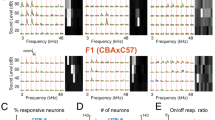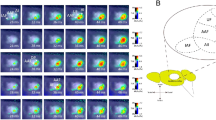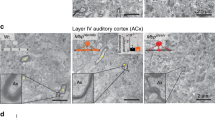Abstract
There are currently no noninvasive imaging methods available for auditory brain mapping in mice, despite the increasing use of genetically engineered mice to study auditory brain development and hearing loss. We developed a manganese-enhanced MRI (MEMRI) method to map regions of accumulated sound-evoked activity in awake, normally behaving mice. To demonstrate its utility for high-resolution (100-μm) brain mapping, we used MEMRI to show the tonotopic organization of the mouse inferior colliculus. To test its efficacy in an experimental setting, we acquired data from mice experiencing unilateral conductive hearing loss at different ages. Larger and persistent changes in auditory brainstem activity resulted when hearing loss occurred before the onset of hearing, showing that early hearing loss biases the response toward the functional ear. Thus, MEMRI provides a sensitive and effective method for mapping the mouse auditory brainstem and has great potential for a range of functional neuroimaging studies in normal and mutant mice.
This is a preview of subscription content, access via your institution
Access options
Subscribe to this journal
Receive 12 print issues and online access
$209.00 per year
only $17.42 per issue
Buy this article
- Purchase on Springer Link
- Instant access to full article PDF
Prices may be subject to local taxes which are calculated during checkout






Similar content being viewed by others
References
Ogawa, S., Lee, T.M., Kay, A.R. & Tank, D.W. Brain magnetic resonance imaging with contrast dependent on blood oxygenation. Proc. Natl. Acad. Sci. USA 87, 9868–9872 (1990).
Narita, K., Kawasaki, F. & Kita, H. Mn and Mg influxes through Ca channels of motor nerve terminals are prevented by vermapil in frogs. Brain Res. 510, 289–295 (1990).
Lin, Y. & Koretsky, A.P. Manganese ion enhanced T1-weighted MRI during brain activation: an approach to direct imaging of brain function. Magn. Reson. Med. 38, 378–388 (1997).
Duong, T.Q., Silva, A.C., Lee, S.P. & Kim, S.G. Functional MRI of calcium-dependent synaptic activity: cross correlation with CBF and BOLD measurements. Magn. Reson. Med. 43, 383–392 (2000).
Aoki, I., Naruse, S. & Tanaka, C. Manganese-enhanced magnetic resonance imaging (MEMRI) of brain activity and applications to early detection of brain ischemia. NMR Biomed. 17, 569–580 (2004).
Pautler, R.G. & Koretsky, A.P. Tracing odor-induced activation in the olfactory bulbs of mice using manganese-enhanced magnetic resonance imaging. Neuroimage 16, 441–448 (2002).
Watanabe, T., Natt, O., Boretius, S., Frahm, J. & Michaelis, T. In vivo 3D MRI staining of mouse brain after subcutaneous application of MnCl2 . Magn. Reson. Med. 48, 852–859 (2002).
Aoki, I., Wu, Y.J., Silva, A.C., Lynch, R.M. & Koretsky, A.P. In vivo detection of neuroarchitecture in the rodent brain using manganese-enhanced MRI. Neuroimage 22, 1046–1059 (2004).
Zaim Wadghiri, Y. et al. Manganese-enhanced magnetic resonance imaging (MEMRI) of mouse brain development. NMR Biomed. 17, 613–619 (2004).
Tucci, D.L., Cant, N.B. & Durham, D. Conductive hearing loss results in a decrease in central auditory system activity in the young gerbil. Laryngoscope 109, 1359–1371 (1999).
Ryugo, D.K., Willard, F.H. & Fekete, D.M. Differential afferent projections to the inferior colliculus from the cochlear nucleus in the albino mouse. Brain Res. 210, 342–349 (1981).
Sanes, D.H. & Constantine-Paton, M. The sharpening of frequency tuning curves requires patterned activity during development in the mouse. Mus musculus. J. Neurosci. 5, 1152–1166 (1985).
Romand, R. & Ehret, G. Development of tonotopy in the inferior colliculus. I. Electrophysiological mapping in house mice. Brain Res. Dev. Brain Res. 54, 221–234 (1990).
Sterbing, S.J. & Schrott-Fischer, A. Neuronal responses in the inferior colliculus of mutant mice (Bronx waltzer) with hereditary inner hair cell loss. Hear. Res. 177, 91–99 (2003).
Ehret, G. Development of absolute auditory thresholds in the house mouse (Mus musculus). J. Am. Audiol. Soc. 1, 179–184 (1976).
Willott, J.F. & Urban, G.P. Response properties of neurons in nuclei of the mouse inferior colliculus. J. Comp. Physiol. 127, 175–184 (1978).
Webster, D.B. & Webster, M. Neonatal sound deprivation affects brain stem auditory nuclei. Arch. Otolaryngol. 103, 392–396 (1977).
Sharma, A., Dorman, M.F. & Spahr, A.J. A sensitive period for the development of the central auditory system in children with cochlear implants: implications for age of implantation. Ear Hear. 23, 532–539 (2002).
Emmorey, K., Allen, J.S., Bruss, J., Schenker, N. & Damasio, H. A morphometric analysis of auditory brain regions in congenitally deaf adults. Proc. Natl. Acad. Sci. USA 100, 10049–10054 (2003).
Shnerson, A. & Pujol, R. Development: anatomy, electrophysiology, and behavior. In The Auditory Psychobiology of the Mouse (ed. Willot, J.F.) 395–425 (Charles C. Thomas, Springfield, Illinois, 1983).
Hall, J.W., Jr., Grose, J.H. & Pillsbury, H.C. Long-term effects of chronic otitis media on binaural hearing in children. Arch. Otolaryngol. Head Neck Surg. 121, 847–852 (1995).
Schilder, A.G. et al. Long-term effects of otitis media with effusion on language, reading and spelling. Clin. Otolaryngol. 18, 234–241 (1993).
Pautler, R.G., Silva, A.C. & Koretsky, A.P. In vivo neuronal tract tracing using manganese-enhanced magnetic resonance imaging. Magn. Reson. Med. 40, 740–748 (1998).
Saleem, K.S. et al. Magnetic resonance imaging of neuronal connections in the macaque monkey. Neuron 34, 685–700 (2002).
Tindemans, I., Verhoye, M., Balthazart, J. & Van Der Linden, A. In vivo dynamic ME-MRI reveals differential functional responses of RA- and area X-projecting neurons in the HVC of canaries exposed to conspecific song. Eur. J. Neurosci. 18, 3352–3360 (2003).
Kalatsky, V.A. & Stryker, M.P. New paradigm for optical imaging: temporally encoded maps of intrinsic signal. Neuron 38, 529–545 (2003).
Bozza, T., McGann, J.P., Mombaerts, P. & Wachowiak, M. In vivo imaging of neuronal activity by targeted expression of a genetically encoded probe in the mouse. Neuron 42, 9–21 (2004).
Kennedy, C. et al. Mapping of functional neural pathways by autoradiographic survey of local metabolic rate with (14C)deoxyglucose. Science 187, 850–853 (1975).
Tai, Y.C. et al. MicroPET II: design, development and initial performance of an improved microPET scanner for small-animal imaging. Phys. Med. Biol. 48, 1519–1537 (2003).
Shukakidze, A., Lazriev, I. & Mitagvariya, N. Behavioral impairments in acute and chronic manganese poisoning in white rats. Neurosci. Behav. Physiol. 33, 263–267 (2003).
Acknowledgements
This research was supported by US National Institutes of Health grants NS38461 and DC06892 (D.H.T.). We thank A. Joyner and G. Fishell (Skirball Institute, NYU School of Medicine) for critical review of this paper. We also thank C. Moreno and D. Rubin for technical assistance in the initial stages of this project and J. Lefman for advice on the volumetric display and analysis routines used for tonotopic mapping. Finally, D.H.T. thanks R. Menon (Robarts Institute, University of Western Ontario) for originally drawing his attention to the potential of MEMRI for activity mapping.
Author information
Authors and Affiliations
Corresponding author
Ethics declarations
Competing interests
The authors declare no competing financial interests.
Supplementary information
Supplementary Fig. 1
Spectra of sound stimuli. (PDF 1115 kb)
Supplementary Fig. 2
Sound stimulus versus quiet. (PDF 3451 kb)
Supplementary Fig. 3
Longitudinal MEMRI results. (PDF 4884 kb)
Rights and permissions
About this article
Cite this article
Yu, X., Wadghiri, Y., Sanes, D. et al. In vivo auditory brain mapping in mice with Mn-enhanced MRI. Nat Neurosci 8, 961–968 (2005). https://doi.org/10.1038/nn1477
Received:
Accepted:
Published:
Issue Date:
DOI: https://doi.org/10.1038/nn1477
This article is cited by
-
SCO-spondin knockout mice exhibit small brain ventricles and mild spine deformation
Fluids and Barriers of the CNS (2023)
-
LA-ICP-MS bioimaging demonstrated disturbance of metal ions in the brain of Parkinson’s disease model mouse undergoing manganese-enhanced MRI
Analytical and Bioanalytical Chemistry (2022)
-
Activity-induced MEMRI cannot detect functional brain anomalies in the APPxPS1-Ki mouse model of Alzheimer’s disease
Scientific Reports (2019)
-
Focal brain lesions induced with ultraviolet irradiation
Scientific Reports (2018)
-
Cocaine differentially affects synaptic activity in memory and midbrain areas of female and male rats: an in vivo MEMRI study
Brain Imaging and Behavior (2018)



